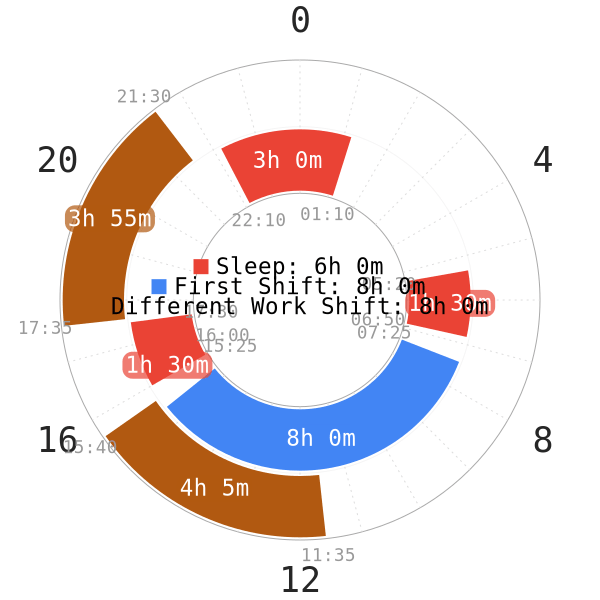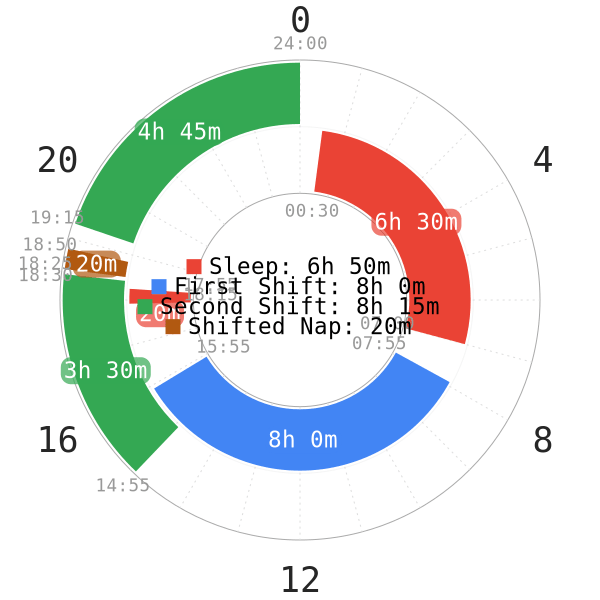Introduction to Rotating Shifts
A rotating shift is a type of shift work that changes on a daily, weekly, biweekly, or monthly basis. If this is the case for you, pulling off any regular polyphasic sleeping schedule will be very difficult. Adapting to a schedule requires consistent sleeping times for at least a month. After adaptation, the whole schedule can be a bit flexible in some cases; however, it will most likely take at least a week for the body to get used to the new schedule. This is similar to jet lag during traveling. Circadian light and food management will, therefore, be essential to keep cores and naps in good circadian placements.
Being sleep deprived this frequently is very unhealthy, regardless of polyphasic sleep or monophasic sleep. The quality of life should improve if you are working with extended schedules. For example, Siesta-extended with the shorter core before work may salvage the situation.
Inconsistent Breaks
Because of the nature of rotating shifts, you may or may not be able to have any consistent break times. If you have no option of napping at consistent times during work, there will be very few viable schedules.

- Non-reducing biphasic schedules should pose little problems as at least some of them should be doable.
- Harder schedules with less total sleep are likely not going to work.
- Some people have reported problems adapting to an 8h gap between the naps on E2.
- Triphasic-extended is a strong candidate, as it can have an 8h break.
Other than these, the work schedule needs to be at very specific times for alternative polyphasic schedules to work.
3 shift rotations, 8h each
You should also aim to be able to do a consistent schedule most days. Try to do a schedule that copes with 2 of the 3 shift times, etc. Every time you have to switch schedules, your adaptation will be set back. Thus, the adaptation progress will only drag out. Thus, having the rotations happen too often (more frequent than once every 2 weeks) or at random will not be possible.
Drastically shifting bedtimes frequently correlates with poor health; consequently, it is probably wise to only do this for a limited amount of time or out of absolute necessity. This does not matter if you are on a monophasic or polyphasic schedule.
2 shift rotations, 8h each
Contrary to the 3 shift rotations, this rotating shift is potentially hospitable for adaptations. Some workplaces have people rotate between first and second shift. Make sure your polyphasic sleep schedule takes into account both shifts’ break times.

- If the break times are inconsistent, there is the possibility of Siesta, E1, or E2.
- These schedules can position the afternoon sleep at the switch change. Hence, you will only need to rotate it about 20 minutes ideally, or realistically 30-40 mins. This can only work if the work schedule changes infrequently.
2 Shift Rotations, 12h Each
This rotating shift will be nearly impossible to pull off, unless the shifts rotate less than once a month. If this is the case, then only biphasic sleep is the best bet. After you have adapted to the base schedule, then it is possible to go through this shift perhaps once a month, then gradually recover on the schedule.
3 Shift Rotations, 8h Each, Random
Switching schedules randomly will not be possible on a regular basis. This will be possible to pull off if done infrequently, once every 2 weeks at most. However, if there is little actual work during one of the shifts, e.g. waiting on call, then switching more frequently might be possible. This would then become very similar to the 2 shift rotation.
Switching Schedules for Infrequent Rotations
During adaptation, it is a bad idea to do a circadian shift. This is because it will confuse the body regarding where to place the sleep times, etc. Regardless, it is possible if necessary. The best option will be to switch to the new schedule cold turkey, possibly with the aid of fast release melatonin if possible. Sleep deprivation can also make it very easy to fall asleep at your new desired sleep times.
Every switch is going to set your adaptation back. However, how much depends on the amount shifted, the current adaptation stage, individual factors, etc.
- You should be able to notice if the shifts change too frequently; it will leave you perpetually disoriented during the whole time between switches.
- Moreover, you will get unpredictably tired or awake during this adjustment. If you only have a couple feel-good days between switches, then adaptation will also be very difficult and long. Avoid this if possible!
Longer Days
Many people are not able to nap during their travel to work; in addition, some are also not able to nap directly before or after work. If this goes with inconsistent break times, almost all schedules will be impossible.
- As long as you have time to have a 2-3 hour gap between cores, Segmented should still be possible.
- If you do not even have enough time at night to split your core with a 2-3 hour gap, polyphasic sleep is unfortunately not possible for you.
- If you have to sacrifice sleep to have enough time for daily activities, it might be better to reconsider your life choices.
Main author: Crimson & GeneralNguyen
Page last updated: 2 April 2021
